While I’m nominally focusing this series of posts on paper circuitry, I’m actually looking to put together a resource for myself and others for any kind of electronics project. To that end, there are some ideas below that have nothing to do with affixing a circuit to paper, but that might still be an interesting or fun alternative.
- 1. Tins
- 2. Repurposed Plastic Enclosure
- 3. 3D Printed Enclosure
- 4. Off the Shelf Plastic Enclosures
- 5. Lamination
- 6. Encapsulation
Tins
Altoids and other tins are cute, small, and easy to source containers for projects. However, since they’re metal be sure to take extra care to wrap your electronics (or the inside of the tin) so that parts aren’t accidentally grounded against the tin. When I put a project in a MintDuino tin I used the paper cardstock from the packaging to insulate the project board.
Anything from paper to plastic should work fine. Cutting holes in the tin required a little more trial and error – since punching holes and using tin snips caused sharp edges. I solved these problems by wrapping the sharp edges in electrical tape – further adding insulation.
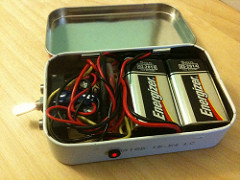
Repurposed Plastic Enclosure
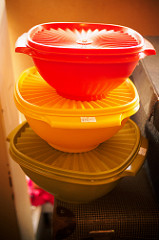
Plastic is probably a superior choice for an electronics project enclosure. As with tins, they come in a variety of shapes/sizes/colors, are cheap-to-free, and sturdy. Unlike tins, they don’t require any special insulation to work.
Besides rescuing containers from the recycle bin, don’t forget to check out your local dollar store. I picked up a particularly nice looking piece of tupperware with a big red screw top lid from the dollar store for a project and couldn’t be happier with it. If you do go to the dollar store, keep your eyes out for more than empty containers. Since everything in the store is a dollar, you can always dump the unused contents of a useful container.
If you do use/reuse a plastic container for a project, I would strongly suggest going very, very, slowly when drilling holes. Seriously, go as slow as you can manage to run the drill because rigid plastic has a tendency to crack under stress. Ideally, drill a small hole, then work your way up with larger bits. If you’ve got the equipment, you may want to consider actually melting holes instead.
3D Printed Enclosure
This is probably my favorite way to encapsulate a project. If you have access to a 3D printer and enjoy 3D design, you can have a cheap bespoke project container.
Off the Shelf Plastic Enclosures
I remember Radio Shack carrying a dizzying array of plastic enclosures when I was a kid. However, these days, I can’t think of a single reason to get an off-the-shelf project enclosure when there are just so many repurpose and dollar store options. I’m really only mentioning this option for the sake of completeness.
Lamination
I’ve really only tried one “lamination” project/experiment so far with very mixed results. However, I feel like this is a promising avenue for exploration and experimentation. These ideas allow for a project being sandwiched under or in between one or more layers of plastic. This could make a small and thin project more durable, while still leaving the parts visible for inspection and teaching. I also like the idea of potentially using additional with extra information printed on them which could be laid over the circuits for additional context and annotation.1
DIY Adhesive Lamination with Tape or Contact Paper
A much cheaper DIY alternative to off-the-shelf adhesive lamination sheets would be to use clear packing tape or contact/shelf paper. Both are inexpensive and durable options, but would need to be cut to size. I actually use the packing tape method to copy and consolidate cards for my minimalistic wallet.
Heat Lamination

I love the idea of designing a project, affixing it to a sheet of clear plastic like an overhead transparency, and then laminating it with a standard heat laminator. As the offspring of two elementary school teachers, I had ready access to a laminator as a kid and have some fond memories of (mis)using these machines. These days desktop sized laminators and the plastic heat lamination films are quite inexpensive and good for lots of different applications besides small electronics projects. My favorite laminator electronics use, ever, is easily this amazing modular solar panel project from rcpederson.
DIY Heat Lamination with Plastic Bags
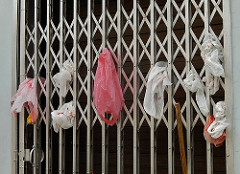
This is an idea I’m really really looking forward to trying. Several years ago at a Benicia Mini Maker Faire I was introduced to the idea of fusing plastic bags together using a household clothes iron. The Makers showing this method let people cut scraps out of thin grocery and shopping bags, layer them between sheets of wax paper, and then fuse them together using an iron. They were using this process to create large colorful sheets of very durable plastic that could be cut and sewn like cloth.
While writing this post it occurred to me that this same method could be applied to paper circuitry, to embed a project within sheets of plastic. There are some interesting parallels to the process of using an iron to fuse aluminum foil to the toner on a laser printed page, described above. Additionally, by layering a project between sheets of plastic one might be able to dispense with some soldering since the fused sheets of plastic might be able to hold parts in direct physical contact with one another.
My Lamination Fail
The project I tried involved using 8B soft graphite art pencil traces and HVAC aluminum tape contact pads on copier paper, “laminated” in place with inexpensive clear packing tape. I believe my experiment didn’t quite work out because the packing tape may have pulled up some of the pencil traces, causing a break in the circuits. If you try to mix pencil graphite and packing tape, just be on the lookout for this possible issue.
There are several self-adhesive lamination plastic sheets available. Basically, there are two sheets of plastic, each with a sticky coating, which sandwich over your desired material. These come in various sizes from business card up to full 8-1/2″ x 11″ sheets.
These tend to be much more expensive than the heat lamination options, but require no additional materials. However, this is a decent option if your project cannot be subjected heat or pressure.
Encapsulation
Silicone Mold Material
As far as I know silicone rubber mold material comes in either a two-part liquid or two-part putty-like format. You mix the liquids in proportion, pour around desired object, cut apart and you get your mold. The putty kind is considerably less messy, but also much more expensive. You mix two balls of putty together well to activate them and they harden/cure into silicone rubber. I haven’t tried it, but I think either would work well to encapsulate a small electronics project.
Sugru
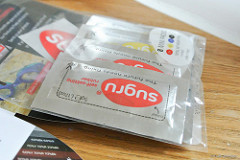
Sugru is a moldable silicone rubber which starts off as a sticky putty which then dries2 into a flexible rubber. It is incredibly useful but very expensive with a relatively short shelf life.3 At roughly $4 per 0.5 gram packet, it is ideal for small fixes around the house, but would be prohibitively expensive for all but the smallest projects.
Oogoo aka DIY Sugru
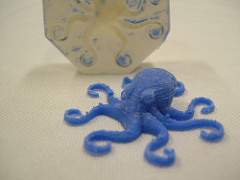
Oogoo is a DIY version of Sugru made from 100% Silicone caulking and corn starch.4 Silicone caulking dries from the outside in and takes about 24 hours. By mixing in corn starch5 the silicone will also dry from the inside out at the same time – in as little as 5 to 10 minutes. Corn starch is easily found in many kitchens and a tube of silicone is very inexpensive (around $4 for a large tube).
I haven’t tried this process yet, but I’ve purchased the silicone and am looking forward to giving it a go. A note of caution – drying silicone is smelly due to the acetic acid released as the silicone cures. It will smell strongly of vinegar while it cures, but should be harmless.
Resins
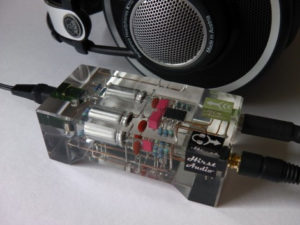
As I mentioned above, some of these ideas have been kicking around in my head for years just waiting for the right inspiration to bring them together. More than four years ago I saw an interesting article on Hackaday about someone who had designed a circuit and then embedded the entire thing within a block of clear resin. There’s so much to love about this process. A resin encased project shouts, “I have made this thing; it is perfect and eternal.”
As I was writing this blog post I began to run into a George R.R. Martin problem – I have so many inspirations, so many ideas, and written so much that I felt I was in danger of never hitting “Publish.”6 Finally I decided to break up the post so that I can share what I have so far. I hope you find it helpful and gives you some ideas of your own – and share them here.
Default Series Title- Though, now that I think about it, this transparency idea could be used as an overlay for any flat project [↩]
- Or cures??? I honestly do not know which is applicable – but I think “cure” is more accurate [↩]
- Let’s just say the cost and shelf life is on par with conductive ink pens. [↩]
- Do not use Silicone II, any quick-curing silicone, or anything less than 100% – this process won’t work [↩]
- and colorants [↩]
- By way of context, this post is about 1,600 words and the draft I began to split up is about 4,000 words and still growing [↩]
Paper Circuits: The Adventure Begins
While I’m a big fan of paper and circuits, I’ve never really given paper circuits/circuitry a shot. Unfortunately, I have no good excuse for this. (Fair warning: I’ve been collecting links and ideas on this topic for several weeks now, and even though I intend to break up the post into more manageable chunks, I have a feeling this is going to be a doozy)
TapeTricity
Years ago Chris Connors, a STEAM educator/maker and friend, had posted some photos and videos about something called, “TapeTricity” and helped hundreds of kids as young as 3 and 4 years old build their very first circuit at Maker Faire 2013. TapeTricity is all about making electronics accessible to people by showing them how to make real circuits using cheap and common components while removing the need for specialized tools and materials. This system of designing circuits made use of several very interesting innovations: aluminum HVAC tape and paperclips along the edges to form electrical contacts.
Aluminum HVAC Tape – Benefits and Limitations
Back in 2013 copper tape was reasonably common in artistic settings for use with soldering stain glass. However, the copper tape wasn’t readily available with conductive adhesive and tended to be more expensive than the aluminum HVAC tape used in Chris’ projects. While the prices of copper tape with conductive adhesive have fallen over the last few years and conductive inks/paints have become more common, pretty much nothing is going to beat aluminum HVAC tape for price per project. However, HVAC tape is not without its limitations. The adhesive is a decent insulator rather than a conductor, the tape only comes in strips about 2 inches wide and must be torn or cut to much thinner strips, and has a tendency to curl at torn edges, and aluminum tape does not take solder well.1 I expect that the non-insulation properties of the underside of the aluminum tape could actually be very useful in conjunction with copper tape – to essentially make for circuit board traces that can cross over one another.
Taped Edges – Contact Points
As you can see from some of the photos above, the edges of the cards had foil tape wrapped over some edges which were then connected to some of the components. The result is that the edges of the paper essentially become functional I/O pins. The nifty thing about this is that it could allow TapeTricity cards to be wired/rewired/networked together.
Paperclips – Alternatives to Alligator Clips
Another interesting feature of TapeTricity comes from the use of paperclips. Paperclips are ubiquitous and cheap23 and, with a little bit of wire, become cheap DIY alligator clips replacements. While individual alligator clips aren’t that expensive (let’s say around $0.25 each?), the cost of providing a number of them to a room full of students would quickly add up.
These TapeTricity cards allowed kids to color and draw on one side of an index card – then bring their designs to life with electronics on the back and through the card.
Lessons from TapeTricity
- HVAC tape is a great choice for paper electronics with a few limitations. The adhesive is an insulator which allows HVAC tape to be leveraged in bridges and there aren’t easy ways to solder to it.
- Edge conductive pads from HVAC tape allow for cards to be powered or networked
- Paperclips and wire are a great cheap DIY alternative to alligator clips
Evil Mad Scientist Labs and Paper Electronics
Evil Mad Scientist Labs is one of my all time favorite open source arts/electronics designers/manufacturers ever. Not only do they enable other people to realize their plans for world domination, they’re pretty cool people. I had the good fortune to be able to visit Evil Mad Scientist Labs (now celebrating their 10th birthday!) a few years ago.
One Sided Circuit Board – paper, conductive ink, and soldering
While there Windell Oskay and Lenore Edman gave me a tour and showed off their awesome single sided mobiüs circuit board.4
Electronic Origami – several methods for electrifying paper
More recently, while researching for this blog post I discovered their simpler, but perhaps more spectacular, origami balloon circuit. EMSL posted several possible methods for electrifying paper. Since the post explains each of these methods in detail, I’ll only list them:
- Using dry mount adhesive to glue aluminum foil to paper
- Using an iron to fuse aluminum foil to freezer paper
- Using an iron to fuse aluminum foil to the toner on laser printed paper
- Lessons on resistors and simple LED/battery combinations inspired by LED throwies
This circuit is beautiful and eerily reminiscent of a certain other cube. If someone hasn’t made an origami LED paper circuitry companion cube, well, this is just a thing that needs to exist in the universe.
Edge-Lit Cards
Another particularly cool post from EMSL is their piece on edge lit holiday cards. The electronics are essentially the same as a simple throwie or TapeTricity circuit, but the use of scored sheets of plastic allow incredibly interesting display possibilities.
Lessons from EMSL
In no particular order, here are some of the lessons I’ve learned from EMSL:
- The conductive ink in the mobiüs circuit has enough resistance that the LED’s don’t really require actual resistors
- Electronic paper projects need not be merely two-dimensional and adding a third dimension can be truly transformative
- Scored or scratched plastic plus paper and carefully designed LED circuits can create amazing display possibilities
Paper Circuits / Paper Circuitry / Electronic Notebook
Just before Maker Faire 2016 I saw a tweet from Jeannine Huffman showing off her development of a paper circuitry robot panda which would cost about $5 per student.
I was astounded by what Jeannine was doing. Where TapeTricity was a great way to introduce kids to electronics, making those same electronics smart by adding a microcontroller could make those same pages smart and interactive. Moreover, a TapeTricity project could be “leveled” up by just wiring the aluminum contact pads to a microcontroller.
Jeannine Huffman’s Notebook
I was fortunate enough to be able to catch up with Jeannine at Maker Faire Bay Area 2016 this year and we compared notebooks. Here’s some pictures of her work:
I regret that I didn’t take more pictures of Jeannine’s notebook, she’s been kind enough to post much of her designs on her website, her Twitter account, her Google Plus page, and in the 21st Century Notebooking Google Plus community.
Lessons from Jeannine Huffman
To just jot down some of the problem solving and ideas I noticed in the few moments when we compared notebooks:
- Mixing off the shelf electronic components and circuit stickers with conductive ink, copper tape, and soldering
- Incorporating electronic components, sensors, and microcontrollers with DIY sensors, switches, and other solutions
- Melding a notebook and electronics – by sketching in, around, and through circuits to provide annotations and instructions
- Finding a way to create a copper tape hinge that could survive repeated opening and closing of the notebook
21st Century Notebooking
The ideas shared in the 21st Century Notebooking Google Plus community are just too numerous for me to do justice. Since my blog posts are as much about me documenting my own discoveries as it is about sharing with you, gentle reader, perhaps you’ll forgive my jotting down just a few of the ideas found within a 30 second scan of this community:
- Paper electronics with mixed media arts crafts
- Paper electronics mixed with origami
- From +Jie Qi and @Chibitronics:
- Conductive fabric to create conductive hinges for use in circuits spanning more than one page in a notebook
- Light up paper helicopters
- Copper tape paper speakers
- UPDATE 10/26/2016: Jie Qi’s “paper-based electronics for creative expression” tutorials have some really great ideas for getting started with paper circuitry. Frankly, this is to be expected from the lady who created Chibitronics and circuit stickers. :) These tutorials are great – and you can see exactly how she refined these ideas to become circuit stickers and the kind of skill building projects seen in Chibitronics books. These tutorials include:
Project Daffodil (Update 10/26/2016)
Project Daffodil is the work of Sian Geraghty, Robert Foster, and Christine Ho as their graduate thesis project for the Masters in Multimedia Program at CSUEB. Their project combines pop-up books, paper circuitry techniques, and 3D printing to provide an interesting introduction to electronics for kids. When I saw them at Mini Maker Faire Rocklin on 10/5/2016 they had combined their work with an iPad app which could interact with some of their 3D printed models infused with conductive material. They’ve been interviewed on the Make Magazine website and published a tutorial on building pop up paper crafts with electronics.
Lessons from 21st Century Notebooking, Circuit Stickers, and Project Daffodil
I think what I learned most out of these projects is that there’s a lot of ways to combine paper circuitry with other interesting and creative ideas like origami, paper crafts, greeting cards, pop up books, and 3D printing.
What’s Next???
Smart sketchbooks, electronic origami, and the ability to program anything. With all these incredible designs, pieces of code, and ideas – where can we go next?
Well, I have a few ideas…
Default Series Title- When I googled “how to solder copper wire to aluminum foil” the top result was a YouTube video which suggested applying a thin layer of oil to the foil, using a soldering iron with solder to heat up the foil, with the oil supposedly preventing the aluminum from oxidizing, then the wire could be soldered to the foil. [↩]
- Or free when you are at a Kinko’s [↩]
- Perhaps the better phrase is “complimentary”? [↩]
- I hope you will, once again, forgive me as I present these items in the order of my discovery, rather than chronological order? [↩]




